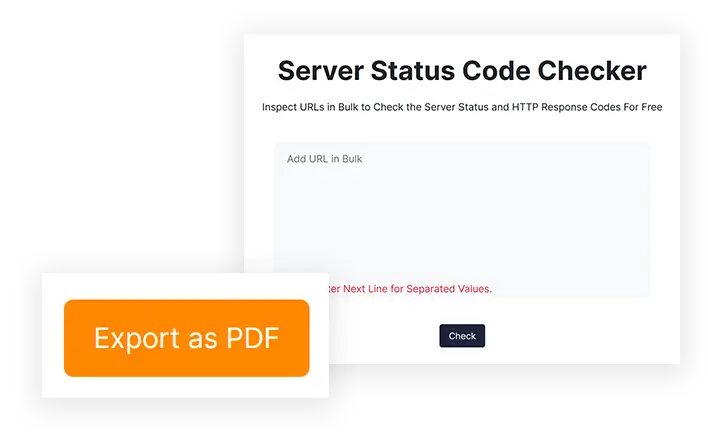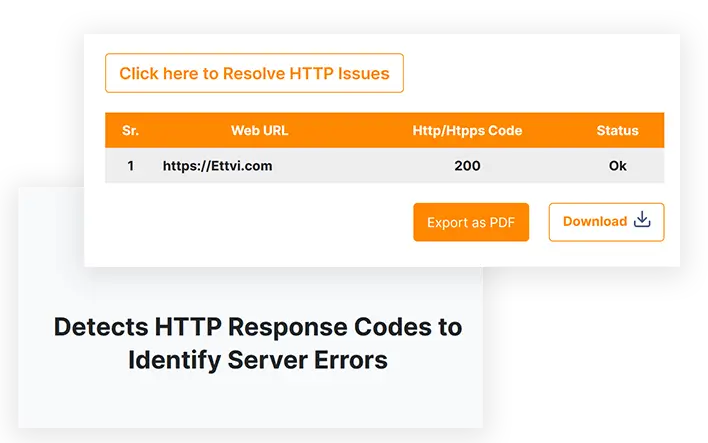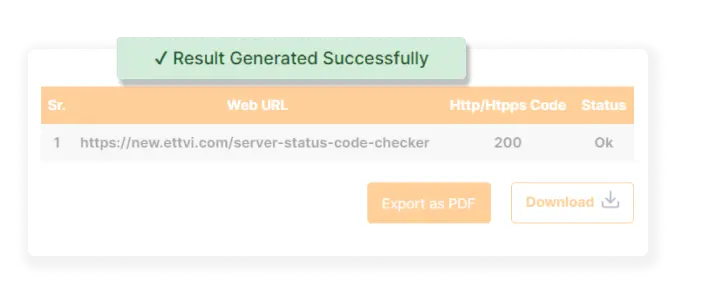Server status indicates whether a web server is operational and responding correctly. It is determined by HTTP status codes like 200 (OK), 301 (Redirect), 404 (Not Found), and 500 (Server Error).
HTTP Status Code Checker
Inspect URLs in Bulk to Check the Server Status and HTTP Response Codes For Free
Features

Detects HTTP Response Codes to Identify Server Errors

Processes Multiple URLs to Check Server Status in Bulk

Identifies HTTP Errors Codes and Discovers URL Redirects
Related Tools
ETTVI’s Server Status Code Checker
Check the server status code of a website to check how well its server complies to the client requests
ETTVI’s Server Status Code Checker enables the webmasters to check the HTTP status code of any website. Just enter the URL to find out whether its web server requires troubleshooting or not. ETTVI’s advanced tool will display the response status codes of the requested web resource and check how well its web server is working to complete the HTTP requests sent by the clients.
The webmasters can easily inspect the informational (100, 101), redirection (301, 302), and success (200) response codes to identify server errors and find out why the users fail to load a website.
Hurry up and leverage ETTVI’s HTTP Status Checker to check the server statuses and http response codes of multiple URLs at the same time.

How to Use ETTVI’s Server Status Code Checker?
Follow these simple steps to check server status code of any web resource with ETTVI’s advanced tool:
STEP 1 “Enter URL(s)”
Use any of the followings ways to enter URL(s):
- Paste the URL(s) in the text box
- Click on to upload an excel spreadsheet
Keep in mind that you can simply enter a single URL or upload URLs in bulk to check the server status codes of multiple links all together.
For example, you enter a single URL “ettvi.com”
STEP 2 “Run the Tool”
Click on ![]() to run ETTVI’s Server Status Checker.
to run ETTVI’s Server Status Checker.
STEP 3 “Check Server Status Code”
ETTVI’s Server Status Code Checker will display the result as follows:
![]()
It will highlight the server statuses and http/https response coded of all the requested domains, just as shown above.
NOTE: In case ETTVI’s Server Status Code Checker displays an error, then it means that your server is having some issues.

Why Use ETTVI’s Server Status Code Checker?
ETTVI’s Server Status Checker enables the users to check the server status and http response codes of multiple URLs at once - for free of cost.
ETTVI’s Server Response Code Checker ensures:
- Enhanced User Experience
ETTVI’s creative team has made it easier than ever for you to check web server status of any domain. The efficient and advanced user interface of ETTVI’s Server Status Checker enables you to enter the URL and then check website server status online - with just one click.
For sure, it's completely unchallenging for the users to understand how ETTVI’s advanced tool works to check the server status codes and detect the HTTP errors for free of cost.
- Quick Server Status Lookup
The easy-to-use interface of ETTVI’s Server Status Checker Tool takes up only a few seconds to process the requested domain name and check its web server status. Whether the user enters a single URL or multiple URLs, it will quickly highlight the status of the respective web servers.
People from all around the globe can easily use ETTVI’s Server Status Checker to debug their web server in real-time.
- HTTP Error Codes Detector
ETTVI’s Server Response Code Checker not only checks the server status but detects the HTTP response codes as well.
For the record, the HTTP responses provide the user (client) with the requested resource. Well, it can be used to inform the client that the requested action is being carried out or has been carried out. Moreover, it may indicate that an error has occurred while processing the request.
Therefore, when the user enters a URL or URLs to check their server status, ETTVI’s Server Status Code Checker tool enables the users to check their http response codes (server status codes) and find out how well the server is processing the client’s request.
In short, it detects 100s, 200s, 300s, 400s, and 500s http response codes to help the webmasters keep a check on their web servers.
- Bulk Status Code Checker
ETTVI’s Server Status Code Checker comes up with an advanced feature - the webmasters can enter URLs in bulk to check the server statuses and http response codes of multiple web resources at a time.
It doesn’t require any subscription fee to check the web server status or identify the http response errors in bulk.
- One-click Downloading
ETTVI’s Web Server Status Checker enables the users to download and save the server statuses and http response codes of all the inspected web resources.
All a user needs to do is to click on the “download”. Consequently, it will automatically save the results in the connected computer system - for free of cost.

Beginner’s Guide to Server Status Checking
Using a server response code is an important part of knowing how information is transmitted. Even if you’re not in charge of configuring the server, you still need to know how to use each piece of code.
Know-How to Keep an Eye on a Server?
If you want to know what's going on with your servers, you need to monitor them. It's a server's job to store and process data that other devices, apps, or users can access at any time. Hundreds or even thousands of simultaneous requests can be handled by a single server. When it comes to managing your IT infrastructure, ensuring that all of your company's servers are running as expected is a must.
The word "server monitoring" is difficult to understand because of the huge variety of servers that are currently in use. It's possible to host a web server on a physical machine, but this is becoming more and more common as virtual servers are housed on the same hardware as dozens of other web servers.
There is a specialised technology for each of these servers that need to be used to monitor and alert to concerns, and a normal "off the shelf" server monitoring program is not likely to be effective for all of them. With this article, we'll help you understand how various server-monitoring tools and services work and the value they provide to a business.
What is the Purpose of Server Monitoring?
To keep your IT environment running well, you need to keep an eye on the performance and uptime of your servers. Customers may leave your site if your web server is down, slow, or having other performance issues. Errors in an internal file server could harm critical corporate data, such as client details or accounting files.
IT managers can use server monitoring to keep tabs on the health of their systems and get a sense of how they are performing. Accessibility and response time are two of the most common functions of a server monitor, which also checks for issues and alerts if they occur. Server monitoring can also be used to predict problems in the future.
Server monitoring is mostly used for real-time data processing, but it can also be used to analyze past data. Analysts may even be able to forecast the exact timing of a server's total shutdown by looking at past weeks or months of performance data.
What are the Most Common Server Monitoring Techniques?
A server monitoring system can be either on-premises (conventional software) or cloud (SaaS). On the other hand, hybrid solutions combine on-premises and cloud technology to provide a unified, tailored solution. Each strategy has a number of benefits and drawbacks.
Premises systems are developed on software deployed on your own in-house hardware. This is the classic software approach with a hefty upfront payment and a maintenance plan for the continuous support this is the classic software approach. It can be difficult and time-consuming to install software on-premises because each installation scenario is unique. When reporting to regulatory bodies, on-premises software may give additional customization possibilities and allow for greater control over data location. It is also more expensive to use on-premises applications.
Solutions that are installed and controlled through the internet are known as cloud/SaaS systems. As there is no requirement for software to be placed on the user's infrastructure, systems can be started and set up quickly, often within a few hours. When it comes to customization and personalization, cloud-based services can be more limited than on-premises options. Monitoring software subscriptions are easier to get started with and less risky than on-premises solutions because of the lack of long-term contracts required by cloud providers.
The majority of on-premises and cloud-based server monitoring solutions provide a mobile implementation as an alternative, although mobile systems aren't the primary type of system. Server monitoring data may be accessed using these mobile solutions, which run on smartphones and tablets. When compared to the capabilities of a regular PC, mobile devices can sometimes fall short. Mobile monitoring is available with the majority of cloud-based solutions and a small number of on-premises systems.
ETTVI’s Server status checker allows you to verify the status of unlimited websites at the same time! The status of a website's server can tell a webmaster if the site is functioning properly.
What are the Status Codes for HTTP Requests?
When a browser requests an HTTP status code, the server responds to it with that status code. While visiting a website, your browser makes a request to the server, which in turn returns a three-digit code known as the HTTP status code.
Using these status codes, your browser and the server may communicate with each other across the Internet. They tell each other if things are going well or if there is a problem between them. In order to minimize downtime on your site, it's important to know how to use status codes. To help search engines and users find your site, you can employ status codes like 301 redirects, which alert bots and visitors that the page has permanently moved.
Each three-digit status code starts with one of five digits from 1 to 5, represented as 1xx or 5xx to signify that range. There is a distinct kind of server response for each range. SEOs and webmasters should have access to ETTVI's host status checker as a standard part of their toolkit. A webmaster or search engine optimizer can use this tool to determine the exact cause of a website outage so that they can take appropriate action.
The current online browsing standard is HTTPS. Those who adopt this protocol can expect additional benefits, such as higher SEO, faster page loading time, and an overall better user experience. When WordPress users switch from HTTP to HTTPS, they gain these
Range of Status Codes
The first digit of a status code provides its broad meaning, so you can predict what the code means even if you don't know the specifics. These should be memorized by any professional SEO.
Successful - 2xx
The primary purpose is to direct the client to a web page with a response code within this range.
Redirection - 3xx
In order to help the client amend their outdated request, these response codes are commonly misunderstood.
Client Error - 4xx
The client is to blame for the failure of the request. When a client requests information that does not exist on the server, the most common response is a broken link.
Server Error - 5xx
The server made a mistake, and the problem lies with the user. In most cases, a developer is needed to resolve this issue.
Important Status Codes for SEOs
Understanding the status codes that have the most impact on SEO is critical for both professionals in the field and website owners alike.
If you're working on a site that's showing a lot of 5xx errors, you'll want to know right away that this is a server issue. 4xx errors have a negative impact on the user experience. Therefore straight away, you should think about any URL modifications or page deletions you may have made. 301 redirects and custom 404 pages can both be used to redirect users to the correct location after knowing the root cause of the problem.
There are a few status codes that every SEO should know, and they're worth memorizing:
Important Status Codes for SEOs
This is the best status code for a page that is used on a regular basis and works properly. Visitor traffic, bot traffic, and link equity all flow seamlessly through linked pages. Now that everything is set up just the way it should be, you don’t need to intervene.
The server status of your websites should be checked on a regular basis by webmasters and SEOs. Use ETTVI’s server checker online that provides free tests run for individual or many URLs.
Permanent Redirect – Status Code (301)
Any time a URL needs to be permanently redirected, the use of a 301 redirect should be considered. This means that visitors and search engine bots will be sent to the new URL if they land on the old page. To ensure that all your hard-earned links to your content are transferred to the new URL, 301 redirects are used. Tests have proven that, despite claims from Google, all 3xx redirects are not processed identically. For permanent redirects, a 301 redirect is the best option.
Temporary Redirect - Status Code (302)
The new page is sent to visitors and bots but not link equity. The use of 302 redirects for long-term modifications is discouraged. As a result, search engine crawlers may not be able to pass along the link equity associated with a 301 redirect.
Not Found – Status Code (404)
This indicates that the server was unable to locate the requested file or page. 404s do not indicate if a page or resource is permanently unavailable. Type in a URL that does not exist to see what this will look like on your site. Like being slammed into a wall, There are many times when a 404 error occurs and the user has no choice but to either try again or leave your site for a different one that provides the information they are seeking.
There will always be certain pages on every website that produce 404 error codes. There are alternatives to redirecting these pages; they don't always need to be. One prevalent misunderstanding is that 301 redirecting 404 error pages to the domain's home page is an SEO best practice. Deliberately misleading users who don't know that the page they're trying to reach doesn’t cause serious problems.
It is best to use 301 redirects to the most relevant website when returning 404 codes. A 301 redirect might be appropriate if your sugar-free cupcakes page no longer exists.
If a URL returns a 404 intentionally, it will prevent search engines from indexing and crawling it over and over again. With a custom 404 page, Google Search Console recommends that you give your visitors the best possible experience. For example, e-commerce companies frequently produce 404 pages when things are out of stock, making them ideal candidates for personalized 404 pages.
Gone - Status Code (410)
If the page you were looking for is no longer accessible via a 410, it signifies that the page has been permanently deleted. Neither the server nor a forwarding address has been set up for this page, which is no longer accessible. A 410 page redirects visitors and bots away from your site to a dead resource. Therefore if you see a 410 link on your site, remove it from your content.
Internal Server Error – Status Code (500)
This status code indicates an issue with the server rather than a lack of pages. A 500 error is a common server problem that will prevent visitors from accessing your website. Whether it's a human visitor or a robot, your link equity will go. You'll want to explore these status codes and solve them as soon as you find them because search engines appreciate sites that are well maintained.
Unavailable Services - Status Code (503)
A 503 response, a subset of the 500 error code, indicates that the server is unavailable. Everyone is asked to return at a later time. This could be due to the server being momentarily overloaded or undergoing maintenance. To ensure that search engines know to return to the page or site soon, a 503 status code is sent.

Frequently Ask Questions
What Is Server Status?
Why Do I Need to Check Server Status?
There are different types of http responses each of which indicates something particular about the web behaviour. The server status helps the webmaster to track the http response to know how a web server complies when a user asks to load the respective web resource.
What If My Server Status Code is 404?
If ETTVI’s tool shows that your server status is 404 then it means the requested web resource can not be loaded by the clients as it may have been moved or missing.
Can I Check Server Status in Bulk?
Yes. ETTVI’s tool enables you to check the Server Status Code of multiple websites at a time. Just enter each domain name (separated by commas) in the search bar to know what is their http response status and code.
Can I Use ETTVI’s Server Status Checker For Free?
Yes. ETTVI’s Server Status Checker can be accessed and used for free of cost. Neither any sign up or subscription fee is required.
What Does ETTVI’s Server Status Checker Do?
ETTVI’s Server Status Checker checks the http response status code of any website. It enables the webmasters to inspect the http response to make sure whether a web server properly responds to the client requests or not.
Why Should I Check Server Status?
Checking server status helps identify downtime, slow responses, or errors affecting website performance, SEO, and user experience. Regular monitoring ensures smooth site accessibility and prevents potential ranking drops.
Does a 404 Error Mean the Server Is Down?
No, a 404 error means the requested page is missing or deleted, but the server is still working. A 500 or 503 error usually indicates server-related issues.

Stay up to date in the email world.
Subscribe for weekly emails with curated articles, guides, and videos to enhance your tactics.
